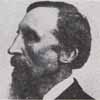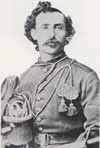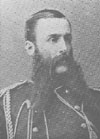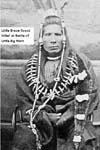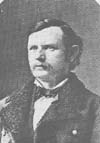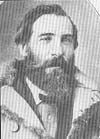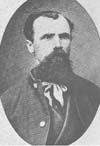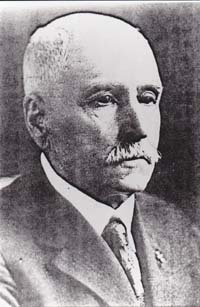Johann Michael Vetter was born in Hessen, Germany, on December 23, 1853. He was a Private in Company L who was killed during the Battle of the Little Bighorn.
Joseph Carroll died on December 23, 1904, in Danville, Vermilion County, Illinois, and was buried in the National Cemetery there. He was a Private in the Band, so he was not present at the battle.
John Martin (left), who immigrated from Italy as Giovanni Martini, died on December 24, 1922, in Brooklyn, New York, and was buried in Cypress Hills National Cemetery there. He was the Trumpeter for Company H who brought the famous “be quick” note to Benteen.
Martin Personeus died in Carlinsville, Illinois, on December 24, 1889. He was a Private in Company L who was on detached service during the battle
John James Carey died in Malone, Grays Harbor County, Washington, on December 24, 1929, and was buried in Pioneer Cemetery in Centralia, Lewis County, Washington. He was a Private in Company B who was with the pack train and in the hilltop fight.
Thomas W. Coleman was born on December 25, 1849, in Troy, New York. He was a Private in Company B who with the pack train and in the hilltop fight.
Edwin B. Wight was born in Casco, Maine, on December 25, 1851. He was a Private in Company B who was on detached service during the battle.
William Millard Caldwell married Blanche Miller on December 25, 1887, in Clearfield, Pennsylvania. He was a Private in Company B who was on detached service during the battle.
John Sivertsen (left) married Anna Olson on December 25, 1889, in Douglas County, Wisconsin.
Thomas Wilford Harrison (right) died on December 25, 1917, in Philadelphia, Pennsylvania, and was buried in the Holy Cross Cemetery in Yeadon, Pennsylvania. He was a Sergeant for Company D who was in the hilltop fight.
Stephen Cowley was born on December 26, 1846, in Sligo, Ireland. He was a Private in Company D who was not present at the battle due to detached service at Yellowstone Depot.

MaxHoehn (left) was born in Berlin, Germany, on December 26, 1854. He was a Private inCompany L who stayed with the regimental papers at Powder River so he was not in the battle.
Timothy Haley was born on December 26, 1846, in Cork, Ireland. He was a Private in Company H who participated in the hilltop fight.
John Meyers died of consumption on December 26, 1877, at Fort Abraham Lincoln in the Dakota Territory and was buried in the Custer National Cemetery in Montana. He was the Saddler for Company C, and he participated in the hilltop fight.
John J. Fay died in Washington, D.C., on December 26, 1932, and was buried in the Soldiers’ Home National Cemetery there. He was a Private in Company D who participated in the valley and hilltop fights.
John Fox also died in Washington, D.C., on December 26, 1932, and was also buried in the Soldiers’ Home National Cemetery there. Like Fay, he was a Private in Company D and participated in the hilltop fight.
Wilson McConnell died on December 27, 1906, in King, Wisconsin, and was buried in the Wisconsin Veterans Memorial Cemetery there. He was a Private in Company K who participated in the hilltop fight.

Peter Thompson (left) was born in Markinch, County Fife, Scotland, on December 28, 1843. He was Private in Company C who was wounded in the hilltop fight. He was awarded the Medal of Honor for his actions during the battle.
John Samuel Ragsdale married Lois Durham on December 28, 1877. He was a Private in Company A who was not present at the battle due to detached service.
David McWilliams died at Fort Meade, South Dakota, on December 28, 1881, and was buried in the National Cemetery there.
The Battle of Wounded Knee occurred in South Dakota on December 29, 1890.
Richard Winick Corwine died during the Battle of Wounded Knee on December 29, 1890, and was buried at the Fort Riley Post Cemetery. He was a Private in Company A on detached service during the Battle of the Little Bighorn.
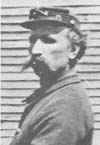
Gustave Korn (left) was a Private in Company I and participated in the hilltop fight. He became the caretaker of Comanche, the only horse that survived the Battle of the Little Bighorn. Korn was killed during the Battle of Wounded Knee on December 29, 1890. He was originally buried in the Pine Ridge Cemetery on Pine Ridge Agency, South Dakota, and was later reinterred at the Fort Riley Post Cemetery in Geary County, Kansas.

George Daniel Wallace (right) was a Second Lieutenant who commanded Company G during the Battle of the Little Bighorn and fought in the valley and hilltop fights. He died on December 29, 1890, during the Battle of Wounded Knee due to gunshot wounds in his head and abdomen. He was buried on January 6, 1891, in the Rose Hill Cemetery in York County, South Carolina.
Frank Hunter died on December 29, 1899, in Washington, D.C., and was buried in the Soldiers’ Home National Cemetery there. He was a Private in Company F who was with the pack train and in the hilltop fight during the Battle of the Little Bighorn.

